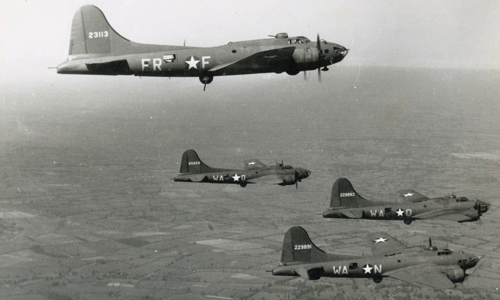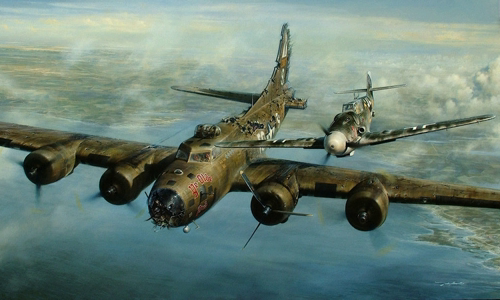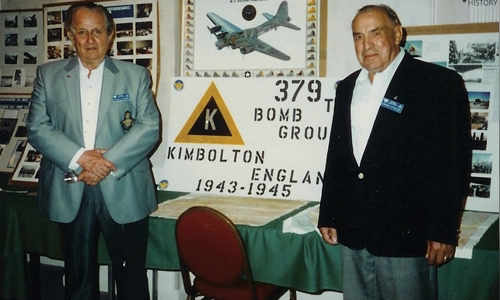Compassion made fighter pilot Franz Stigler escort the US bomber to safety even after a fierce battle.
In 1943, the Allies launched fierce air strikes to destroy Nazi industry, depleting its economic and defense potential. Lieutenant Charles "Charlie" Brown was one of the US B-17F bombers involved in the operation.

A B-17F bomber squadron of 379 Air Force Photo: USAF
During the air raid on December 20, 1943, Lieutenant Brown struggled to control the B-17F bomber that was heavily damaged in German airspace after being hit by enemy anti-aircraft fire. Brown suffered a shoulder injury, Hugh Eckenrode tail gunner died, and the rest of the crew were also seriously injured.
The B-17F was hit twice by anti-aircraft artillery when it approached the Focke-Wulf aircraft factory in Bremen, forcing the crew to turn off an engine and decelerate. This left them behind the 379 bomber squadron, and was attacked by German fighters.
Up to 15 German fighters attacked the B-17F. Its entire tail was broken, its glass nose was also broken, its electrical, hydraulic, communications and air supply systems were broken, and many cables protruded through holes in the fuselage. However, American bombers continued to fly.
Brown fainted in a short time due to pain, blood loss and lack of oxygen, while the B-17F lost control and drove its nose to the ground. This seems to have saved the crew's life, when the German pilots thought that the B-17F would crash into the ground and decided to leave, not to pursue.
Brown regained consciousness when the plane was only a few hundred meters from the ground. He tried to fly the plane to the west and to a safe place in England more than 400 km away.
The pilot could not bring the B-17F to an altitude of over 300 meters and realized that he was near a German airport. Shortly thereafter, he spotted an enemy Bf 109 fighter approaching from the side, so close that he could see the German pilot signaling a request for an American bomber to land.

Paintings depicting a German fighter escort of a US bomber Photo: War History
The machine gunners on the B-17F were all injured and could not fire the German fighters. Brown shook his head, signaling his refusal to land, though he was not sure if he could fly to England.
The Bf 109 flew next to the US bomber for a short time before backing away and raising its altitude. Brown thought the enemy would fire but nothing happened, before he was surprised to realize that the fighter was escorting him. German fighters maintained that distance with American bombers even though the two aircraft had crossed the coastline and headed for the North Sea.
After leaving the coast, the new Bf 109 approached American bombers. Brown saw the German pilot raising a salute, then turned around and returned to the mainland.
The B-17F then landed safely on the base of the 448 bomber squadron on British soil. With the exception of the tail gunner, all crew members survived. Brown recounted the incident, but the US Air Force decided to keep it a secret, because German pilots spared their lives and escorted American planes back as deemed incompatible with wartime messages.
Charlie Brown survived World War II, returned to college and rejoined the US Air Force in 1949. He retired as colonel in 1965 and never told anyone about the event on December 20, 1943. until the meeting of former pilots in 1986. The story made many people questioned, even Brown himself doubted himself, claiming that he imagined the incident while half-awake due to his injuries. .
Brown decided to look for a German pilot to escort him. In 1990, he received a letter from a man named Franz Stigler living in Canada. In the letter, Stigler stated that he was the German pilot who escorted Brown's B-17F.

Brown (left) and Stigler in one meeting Photo: War History
Stigler is a pilot of the 27th Fighter Squadron of Germany with a record of 27 shots down enemy aircraft. On the morning of December 20, 1943, he controlled the Bf 109G-6 against the American bomber squadron. Brown's B-17F flew over the airport while Stigler's fighter was being refueled. Although the fighter was damaged in the previous battle, the German pilot still took off with the desire to strike US aircraft.
However, when approaching the opponent, Stigler discovered it was seriously damaged. He could see the gunner gunshot body on the tail and crew members injured through holes in the US aircraft.
The 27th Air Force commander had previously told his subordinates that they should never shoot the enemy pilot who was skydiving. Although the crew of the B-17F had not yet escaped, they clearly lost their ability to fight, so Stigler decided not to attack.
He flew beside him and motioned for Brown to land. Stigler said the action was not intended to require Brown to surrender, but because he thought the B-17F was so badly damaged that it could not make its way to Britain. When the enemy refused, Stigler began flying close to the B-17 to prevent the German anti-aircraft batteries from firing on the coast. He flew with the bombers until it left German airspace.
Stigler has never told anyone about this for fear of being punished by his superiors, though he is also curious about the fate of the American bombers he spared. He continued to fight until World War II ended and emigrated to Canada in 1953.
Upon hearing the story of Charlie Brown in 1990, Stigler confirmed all the facts as true. The two were surprised to discover that they lived more than 300 km apart. They become close friends and often visit each other, as well as tell others about what went through. Both pilots died just a few months apart in 2008.



 AKSheriff
AKSheriff







